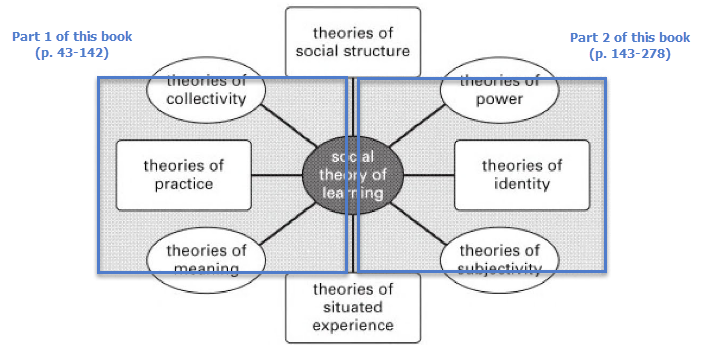Introduction
These notes are part of a series for the book.
Wenger, E. (1998) ‘Ch. 2, Community’, in Communities of Practice: Learning, Meaning, and Identity, Cambridge, Cambridge University Press.
Outline
- A conceptual perspective: Theory and practice
- COPs are everywhere
- Rethinking learning
- The practicality of theory
- Intellectual context
- Structure of this book
- Vignette 1: Welcome to claims processing!
- Vignette 2: The “C, F, and J” thing
- Coda 0: Understanding
Notes
‘Learning is inherent in human nature’ (from the 13 principles defining learning, Wenger, 1998, p. 226).
There are many learning theories, and they are useful in that they focus on different dimensions of learning, which is fundamentally multi-dimensional. Wenger is not proclaiming that his theory replaces others, just that it adds to the body of knowledge. Wenger contends that a social theory of learning includes four related theories. In the figure below, he marks the theories discussed in this book with a gray background (and I’ve added blue boxes to indicate page numbers in the book):
Refined intersection of intellectual traditions, with my modifications (Wenger, 1998, p. 14)
Wenger makes 4 assumptions (Wenger, 1998, p. 4):
- People are social
- Knowledge is competence in an enterprise
- Knowing is participating in an enterprise
- Learning produces meaning
Examples of communities of practice (COPs):
- Families
- Workers: The company, and also their day-to-day people they work with (although later he seems to contradict this, saying that a company may have constellations of COPs)
- Students at school: The school, the classroom, the playground
- Hobbyists
- Support groups
- Science labs
- Online communities
- Gangs
A practice is inherently social. It implies doing, and doing in an ‘historical and social context that gives structure and meaning to what we do’ (Wenger, 1998, p. 47).
It includes the explicit (such as tools, documents, symbols, roles, procedures, and agreements) and the tacit (such as rules of thumb, underlying assumptions, shared views, and “common sense”, which is ‘sense held in common”).
- COPs are where we define that which is common sense, through mutual engagement.
- Wenger does not use the word “practice” as an antonym for theory. COPs include both theory and practice.
